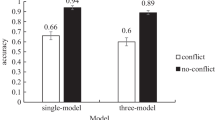Abstract
Whereas classic work in judgment and decision making has focused on the deviation of intuition from rationality, more recent research has focused on the performance of intuition in real-world environments. Borrowing from both approaches, we investigate to which extent competing models of intuitive probabilistic decision making overlap with choices according to the axioms of probability theory and how accurate those models can be expected to perform in real-world environments. Specifically, we assessed to which extent heuristics, models implementing weighted additive information integration (WADD), and the parallel constraint satisfaction (PCS) network model approximate the Bayesian solution and how often they lead to correct decisions in a probabilistic decision task. PCS and WADD outperform simple heuristics on both criteria with an approximation of 88.8 % and a performance of 73.7 %. Results are discussed in the light of selection of intuitive processes by reinforcement learning.
Similar content being viewed by others
References
Bargh J. A., Chartrand T. L. (1999) The unbearable automaticity of being. American Psychologist 54: 462–479
Beach L. R., Mitchell T. R. (1978) A contingency model for the selection of decision strategies. Academy of Management Review 3: 439–449
Betsch T., Glöckner A. (2010) Intuition in judgment and decision making: Extensive thinking without effort. Psychological Inquiry 21: 279–294
Busemeyer J. R., Townsend J. T. (1993) Decision field theory: A dynamic-cognitive approach to decision making in an uncertain environment. Psychological Review 100: 432–459
Claxton G. (1998) Knowing without knowing why. The Psychologist 11: 217–220
Cohen L. J. (1981) Can human irrationality be experimentally demonstrated?. The Behavioral and Brian Sciences 4: 317–370
Czerlinski J., Gigerenzer G., Goldstein D.G. (1999) How good are simple heuristics?. In: Gigerenzer G., Todd P.M., The ABC Research Group (eds) Simple heuristics that make us smart. Oxford University Press, New York, pp 97–118
Dougherty M. R. P., Gettys C. F., Ogden E. E. (1999) MINERVA-DM: A memory processes model for judgments of likelihood. Psychological Review 106: 180–209
Gigerenzer G. (2007) Gut feelings: The intelligence of the unconscious. Penguin Books, London
Gigerenzer G., Brighton H. (2009) Homo heuristicus: Why biased minds make better inferences. Topics in Cognitive Sciences 1: 107–143
Gigerenzer G., Todd P.M., The ABC Research Group (1999) Simple heuristics that make us smart. Oxford University Press, New York
Gilovich T., Griffin D., Kahneman D. (2002) Heuristics and biases: The psychology of intuitive judgment. Cambridge University Press, New York
Glöckner A., Betsch T. (2008a) Modeling option and strategy choices with connectionist networks: Towards an integrative model of automatic and deliberate decision making. Judgment and Decision Making 3: 215–228
Glöckner A., Betsch T. (2008b) Multiple-reason decision making based on automatic processing. Journal of Experimental Psychology: Learning, Memory, and Cognition 34: 1055–1075
Glöckner A., Betsch T. (2012) Decisions beyond boundaries: When more information is processed faster than less. Acta Psychologica 139: 532–542
Glöckner A., Betsch T., Schindler N. (2010) Coherence shifts in probabilistic inference tasks. Journal of Behavioral Decision Making 23: 439–462
Glöckner A., Bröder A. (2011) Processing of recognition information and additional cues: A model-based analysis of choice, confidence, and response time. Judgment and Decision Making 6: 23–42
Glöckner A., Witteman C. L. M. (2010) Beyond dual-process models: A categorization of processes underlying intuitive judgment and decision making. Thinking & Reasoning 16: 1–25
Hammond K. R., Hamm R. M., Grassia J., Pearson T. (1987) Direct comparison of the efficacy of intuitive and analytical cognition in expert judgment. IEEE Transactions on Systems, Man, and Cybernetics 17: 753–770
Hilbig B. E., Richter T. (2011) Homo heuristicus outnumbered: Comment on Gigerenzer and Brighton (2009). Topics in Cognitive Science 3: 187–196
Hochman G., Ayal S., Glöckner A. (2010) Physiological arousal in processing recognition information: Ignoring or integrating cognitive cues?. Judgment and Decision Making 5: 285–299
Hogarth R. M. (2001) Educating intuition. University of Chicago Press, Chicago
Hogarth R.M. (2005) Deciding analytically or trusting your intuition? The advantages and disadvantages of analytic and intuitive thought. In: Betsch T., Haberstroh S. (eds) The routines of decision making. Erlbaum, Mahway, NJ, pp 67–82
Hogarth R. M., Karelaia N. (2007) Heuristic and linear models of judgment: Matching rules and environments. Psychological Review 114: 733–758
Holyoak K. J., Simon D. (1999) Bidirectional reasoning in decision making by constraint satisfaction. Journal of Experimental Psychology: General 128: 3–31
Juslin P., Nilsson H., Winman A. (2009) Probability theory, not the very guide of life. Psychological Review 116: 856–874
Kahneman D., Frederick S. (2002) Representativeness revisited: Attribute substitution in intuitive judgment. In: Gilovich T., Griffin D., Kahneman D. (eds) Heuristics and biases: The psychology of intuitive judgment. Cambridge University Press, New York, pp 49–81
Lee M. D., Cummins T. D. R. (2004) Evidence accumulation in decision making: Unifying the “take the best” and the “rational”models. Psychonomic Bulletin and Review 11: 343–352
Lopes L. (1991) The rhetoric of irrationality. Theory and Psychology 1: 65–82
Payne J. W., Bettman J. R., Johnson E. J. (1988) Adaptive strategy selection in decision making. Journal of Experimental Psychology: Learning, Memory, and Cognition 14: 534–552
Roe R., Busemeyer J. R., Townsend J. (2001) Multiattribute decision field theory: A dynamic, connectionist model of decision making. Psychological Review 108: 370–392
Thagard P., Millgram E. (1995) Inference to the best plan: A coherence theory of decision. In: Ram A., Leake D. B. (eds) Goal-driven learning. MIT Press, Cambridge MA, pp 439–454
Usher M., McClelland J. L. (2001) The time course of perceptual choice: The leaky, competing accumulator model. Psychological Review 108: 550–592
Author information
Authors and Affiliations
Corresponding author
Rights and permissions
About this article
Cite this article
Jekel, M., Glöckner, A., Fiedler, S. et al. The rationality of different kinds of intuitive decision processes. Synthese 189 (Suppl 1), 147–160 (2012). https://doi.org/10.1007/s11229-012-0126-7
Received:
Accepted:
Published:
Issue Date:
DOI: https://doi.org/10.1007/s11229-012-0126-7




